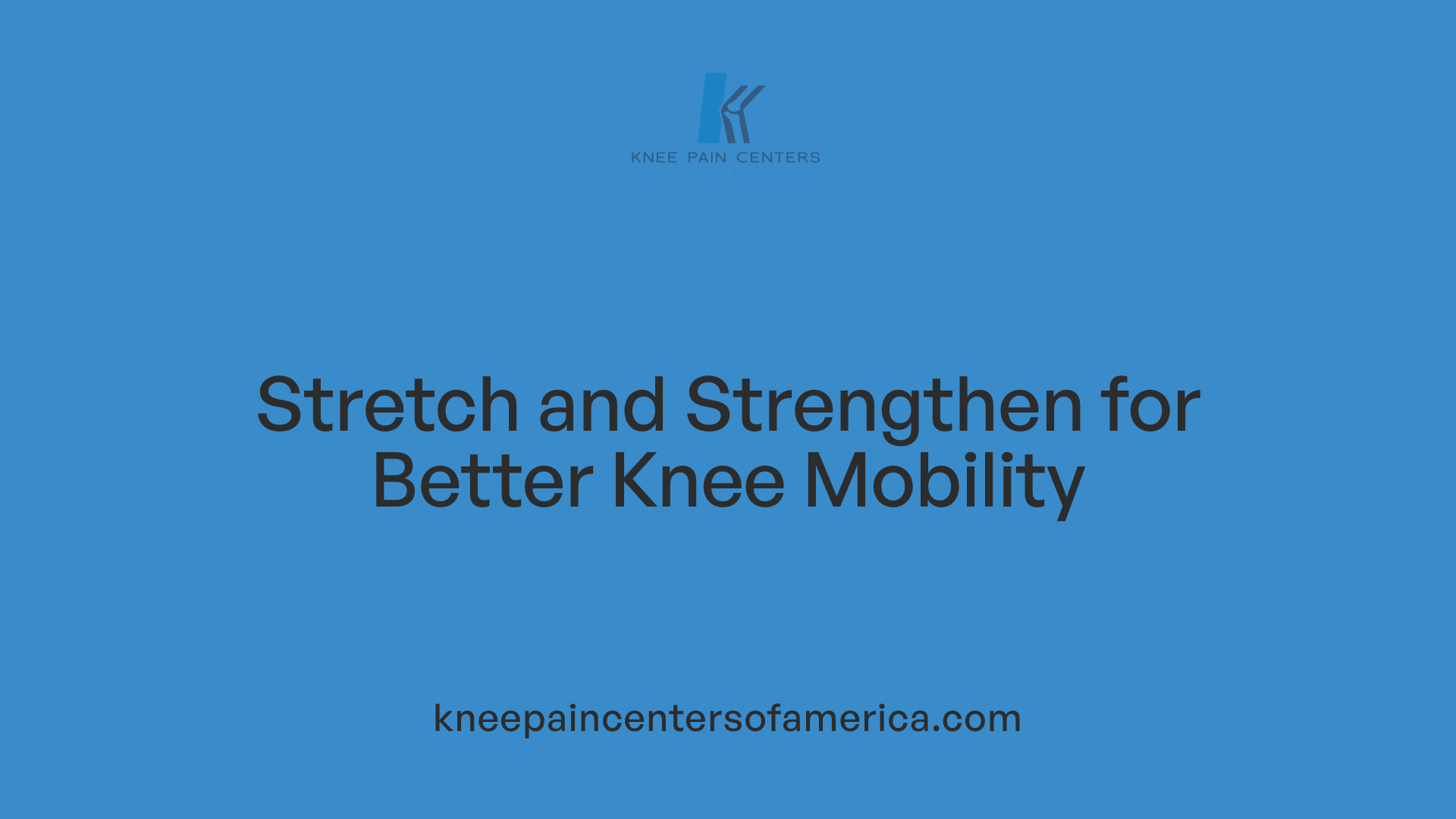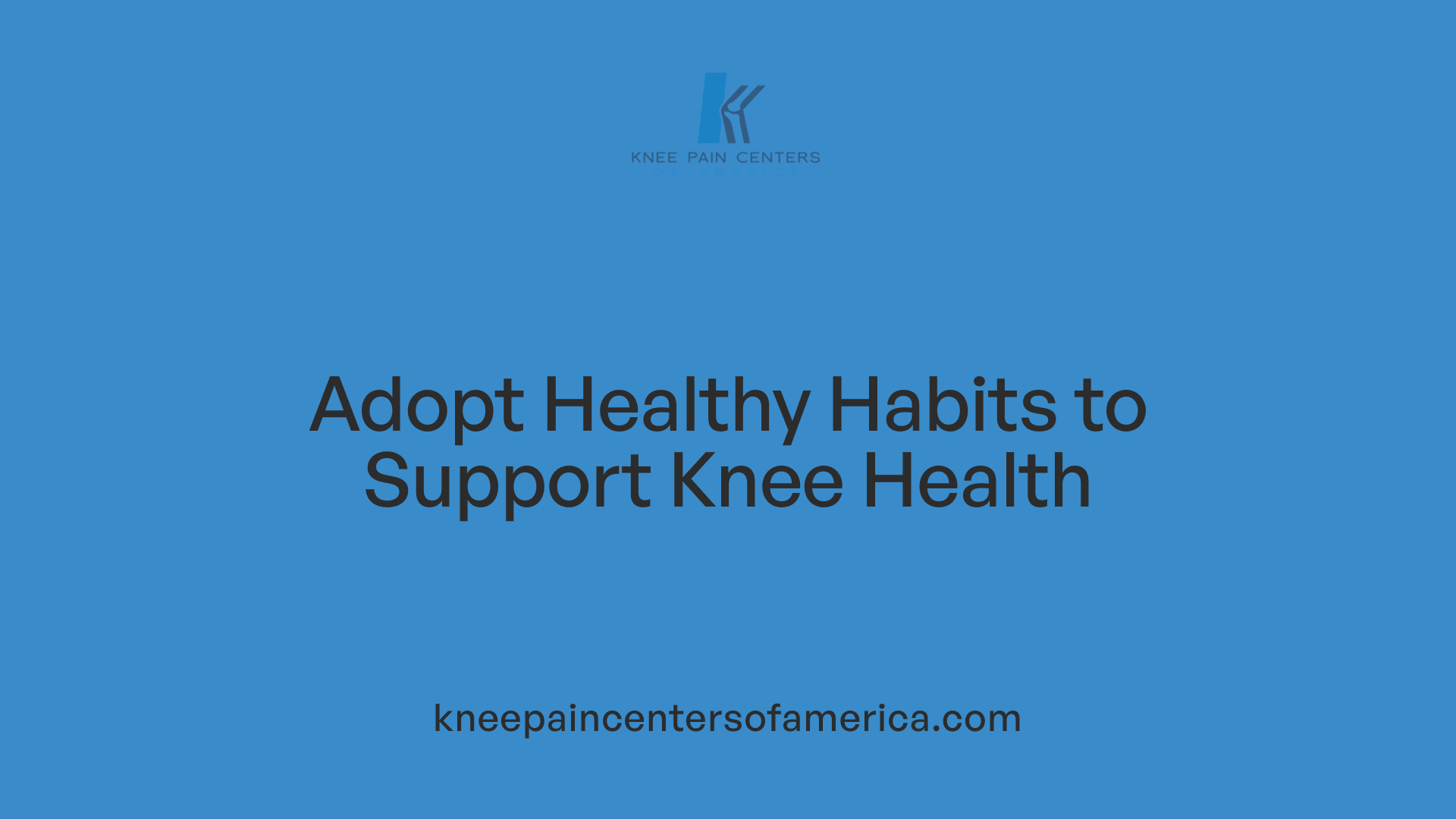Understanding Knee Pain in Active Seniors
Knee pain is a common concern among seniors who wish to remain active and independent. As we age, the wear and tear on joints, combined with factors like weight, injury, and chronic conditions such as osteoarthritis, can lead to discomfort and reduced mobility. However, with targeted strategies, lifestyle modifications, and proper medical guidance, active seniors can manage and even prevent knee pain, ensuring a vibrant, mobile lifestyle well into later years.
Effective Exercises for Knee Pain Management

What are effective exercises for managing knee pain in active seniors?
For seniors dealing with knee pain, staying active is crucial. Gentle, low-impact activities like walking, swimming, and stationary biking support joint health without putting too much stress on the knees. These exercises help maintain mobility, strengthen supporting muscles, and improve overall function.
Targeted strengthening exercises are also beneficial. Movements such as wall squats, knee extensions, mini lunges, straight leg raises, and standing side leg raises help build muscle around the knee, which provides better support and stability. Regular practice of these exercises can reduce pain and prevent further joint damage.
Flexibility plays an important role in knee health. Stretching exercises like hamstring and quadriceps stretches can decrease stiffness and improve range of motion, making daily activities easier and less painful.
Personalized programs developed by physical therapists—either in-person or through remote consultations—are ideal. These programs ensure that exercises are suited to individual needs, strengthening muscles safely while avoiding undue strain.
Consistent, gradual activity with proper technique can significantly enhance knee function. Combining these exercises with a healthy lifestyle helps manage pain effectively, allowing seniors to stay active and independent.
Medical and Conservative Treatment Options

What are recommended treatment options for knee pain in older adults?
Managing knee pain in seniors involves a mix of conservative and medical treatments tailored to individual needs. Physical therapy and supervised exercise routines play a vital role in strengthening muscles around the knee, improving flexibility, and reducing pain. Regular, gentle activities like walking, swimming, or stationary biking are encouraged.
Supportive devices such as knee braces and compression bandages can help stabilize the joint, decrease strain, and provide relief during daily activities. Wearing supportive footwear with proper cushioning and support is also beneficial.
Medications like nonsteroidal anti-inflammatory drugs (NSAIDs) are commonly prescribed to alleviate inflammation and pain. In some cases, corticosteroid injections provide quick relief for severe inflammation.
For persistent symptoms, minimally invasive procedures like hyaluronic acid injections can improve joint lubrication and reduce discomfort. Arthroscopic surgery, which involves smaller incisions, may be considered to repair torn tissues or remove damaged cartilage.
In advanced cases where joint damage is extensive, knee replacement surgery offers a durable solution. It's important for seniors to consult healthcare professionals to develop a personalized treatment plan that considers the severity of their condition, lifestyle, and overall health.
Summary of Treatments
| Treatment Type |
Examples |
Purpose |
Additional Info |
| Conservative |
Exercise, weight management, supportive devices |
Reduce stress, improve stability |
Emphasize gentle, regular activity |
| Medications |
NSAIDs, corticosteroid injections |
Control inflammation, pain relief |
Use under medical guidance |
| Minimally invasive |
Hyaluronic acid injections, arthroscopic repair |
Improve joint function, repair damage |
Suitable for early or moderate arthritis |
| Surgical |
Knee replacement |
Long-term solution for severe damage |
Usually considered after other options |
By combining these approaches, many seniors can enjoy reduced pain, increased mobility, and a better quality of life.
Lifestyle Modifications and Self-Care Techniques

What lifestyle changes and self-care techniques can help manage knee pain?
Managing knee pain involves adopting a combination of gentle exercises and healthy habits. Regular weight-bearing activities like walking, yoga, and Tai Chi can strengthen the muscles, ligaments, and joints that support the knees. These activities improve flexibility, balance, and overall joint stability, which helps reduce discomfort.
Avoiding long periods of inactivity or excessive sitting is also important. Sedentary behavior weakens supporting muscles, increases the risk of osteoporosis, and can worsen conditions like knee chondromalacia. Keeping active in moderate amounts maintains joint health and prevents stiffness.
Maintaining a healthy weight is one of the most effective ways to reduce stress on the knees. Losing even a small amount of weight can significantly decrease the load on knee joints—about four pounds of pressure per pound lost. This reduces pain and slows joint degeneration.
Incorporating stretching and strengthening routines, including targeted exercises for joint stability, supports joint function. Proper posture and balance exercises further enhance joint health by preventing abnormal stresses.
It's essential to develop an activity plan tailored to individual needs and limitations. Consulting with healthcare professionals ensures that chosen activities promote health without risking injury. Regular, consistent new routines can manage symptoms and improve mobility, contributing to a better quality of life for those with knee issues.
Prevention and Maintenance of Joint Health
 Maintaining healthy joints, especially in older age, requires a combination of lifestyle habits and preventive measures. Regular physical activity is one of the most effective ways to keep joints functioning well. Aim for at least 150 minutes of moderate activity each week—this includes walking, cycling, swimming, and other low-impact exercises. These activities help strengthen supporting muscles, improve blood flow, and promote joint regeneration.
Maintaining healthy joints, especially in older age, requires a combination of lifestyle habits and preventive measures. Regular physical activity is one of the most effective ways to keep joints functioning well. Aim for at least 150 minutes of moderate activity each week—this includes walking, cycling, swimming, and other low-impact exercises. These activities help strengthen supporting muscles, improve blood flow, and promote joint regeneration.
Supporting bone health is equally important. Consuming a diet rich in calcium, vitamin D, and other nutrients helps maintain bone strength. Avoiding excess soft drinks, caffeine, and alcohol can also protect bones and joints from deterioration.
Choosing supportive footwear that has good cushioning and proper alignment prevents undue stress on the knees and other joints. Proper posture during daily activities and pacing oneself to avoid overexertion can further reduce joint stress.
Monitoring your joint symptoms is crucial. Being alert to pain or stiffness and consulting healthcare professionals when needed can prevent minor issues from worsening. Developing a personalized plan with your doctor or physical therapist ensures targeted efforts to maintain joint health as you age.
Remember, staying active, maintaining a healthy weight, and protecting your joints through lifestyle choices are all vital steps. These measures not only help in reducing pain but also support overall mobility and quality of life for seniors.
Non-Medication Strategies for Managing Knee Pain
Are there non-medication approaches to managing knee pain for active seniors?
Yes, seniors can effectively manage knee pain through various non-medicinal strategies. Regular engagement in gentle exercises, such as walking, swimming, and stationary biking, helps strengthen the muscles supporting the knee. These activities improve joint flexibility and reduce stiffness, making daily movements easier.
Physical therapy is another vital component. Often accessible through telehealth services, physical therapy programs focus on targeted exercises to strengthen the muscles around the knee, enhance the range of motion, and teach proper movement techniques to prevent injury.
Incorporating stretching routines and balance activities like yoga or Tai Chi can further strengthen joint stability and improve overall mobility. Supporting these efforts with proper lifestyle changes—such as maintaining a healthy weight, staying well-hydrated, and wearing supportive footwear—can significantly reduce pain and slow disease progression.
Supportive devices, including knee braces and orthotic insoles, also help to reduce strain on the joints and improve mobility. Additionally, heat therapy can soothe muscles and enhance flexibility, while cold therapy is effective for reducing swelling and inflammation.
Together, these approaches form a comprehensive, non-invasive way for seniors to cope with knee pain, promote joint health, and maintain an active lifestyle.
The Role of Diet and Nutrition in Knee Health
What diet, weight management, and other interventions can help reduce knee pain and improve mobility?
A healthy, balanced diet plays a vital role in supporting knee health and managing pain. Consuming whole foods rich in essential nutrients can help reduce inflammation and support joint function.
The Mediterranean diet is especially beneficial. It emphasizes fruits, vegetables, fish, nuts, and beans, which are natural anti-inflammatory foods. These dietary choices can help limit joint swelling and stiffness.
Supporting bone strength is also important. Adequate intake of calcium and vitamin D helps maintain bone density and prevents osteoporosis, which can exacerbate joint problems. Dairy products, leafy greens, fatty fish, and fortified foods are good sources.
Avoiding excess caffeine, soft drinks, and alcohol is equally important. These substances can contribute to bone loss, increase inflammation, and potentially accelerate cartilage wear.
Proper hydration is essential for lubricating joints. Drinking plenty of water helps maintain the synovial fluid that cushions joints, reducing stiffness and discomfort.
Combining dietary improvements with regular physical activity and weight management can dramatically reduce knee pain. Losing excess weight decreases stress on weight-bearing joints. Even a small reduction in weight can significantly lessen knee load.
In summary, a diet rich in anti-inflammatory foods, supportive nutrients, and adequate hydration, alongside weight control and regular movement, offers a comprehensive approach to improving mobility and reducing knee discomfort.
Supporting Overall Well-Being and Pain Management
How can I manage pain and improve mental well-being while dealing with knee pain?
Managing knee pain is not just about physical treatments; mental and emotional health play a significant role. Techniques such as meditation and deep breathing exercises help calm the mind and reduce stress, which can worsen pain perception. Incorporating relaxation practices into daily routines can lead to better pain control and a more positive outlook.
Complementary therapies like massage and acupuncture are often used to alleviate muscle tension and promote relaxation. Heat therapy can relax tight muscles and increase blood flow, while cold therapy can reduce inflammation and swelling around the joint.
The connection between physical and emotional health is strong. Engaging in activities that promote psychological well-being—such as social interactions, hobbies, or therapy—can significantly improve overall quality of life. Cognitive-behavioral therapy provides strategies to cope with chronic pain and emotional distress.
Together, these approaches create a comprehensive pain management plan. They address both physical discomfort and emotional resilience, ensuring better management of knee pain and enhanced mental well-being.
Living Actively with Healthy Knees
Effective management of knee pain involves a holistic approach that combines regular physical activity, lifestyle modifications, targeted exercises, proper nutrition, and medical interventions when necessary. Active seniors should prioritize maintaining a healthy weight, practicing safe exercise routines, and adopting supportive habits to prevent deterioration and reduce discomfort. Engaging in preventive measures and self-care techniques can lead to improved mobility, reduced pain, and a better quality of life. By staying informed and proactive, seniors can continue to enjoy active, fulfilling lifestyles well into their later years.
References